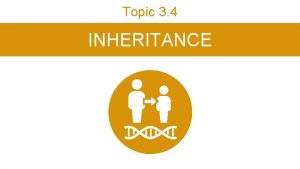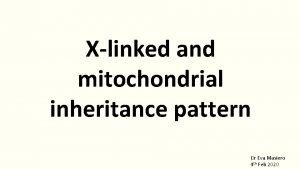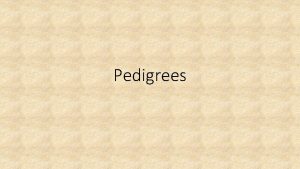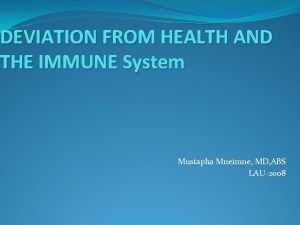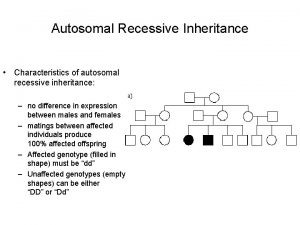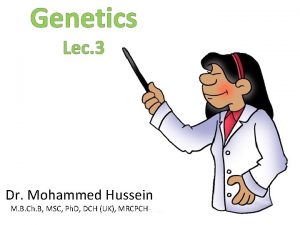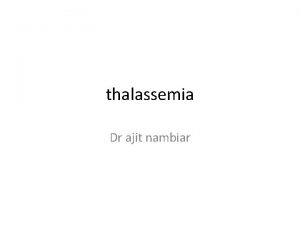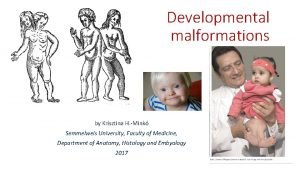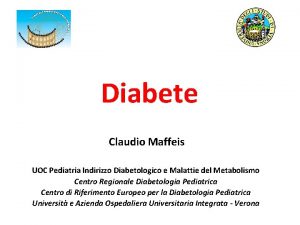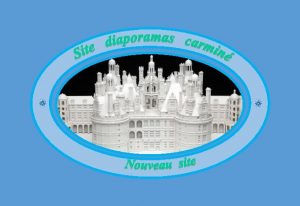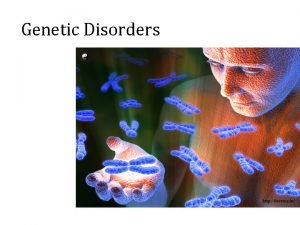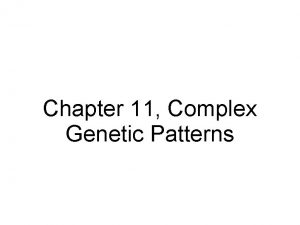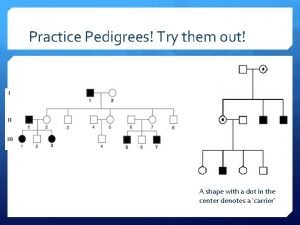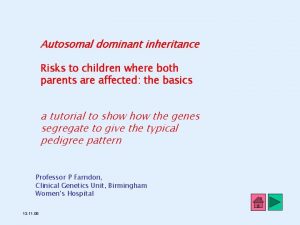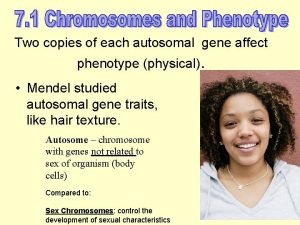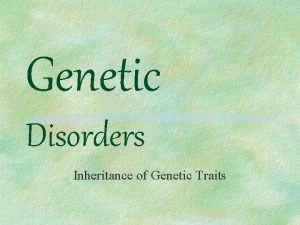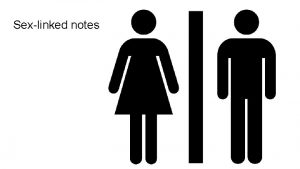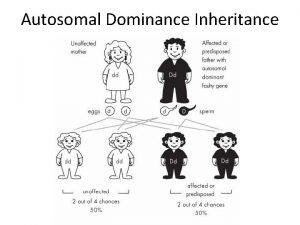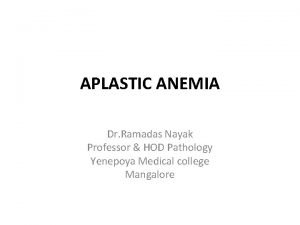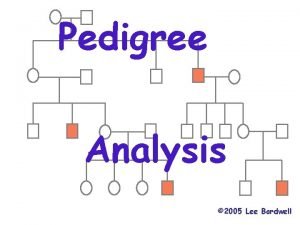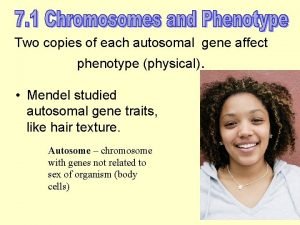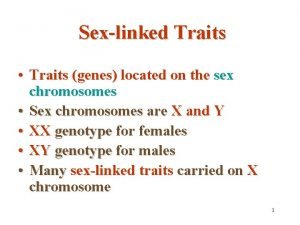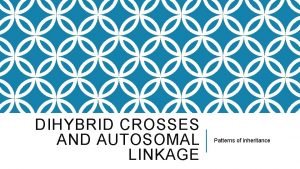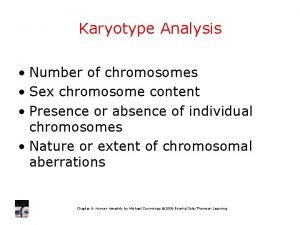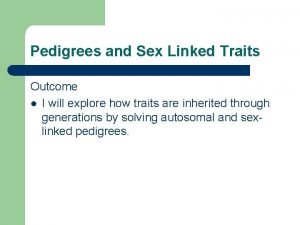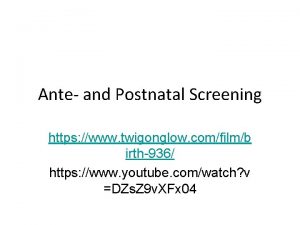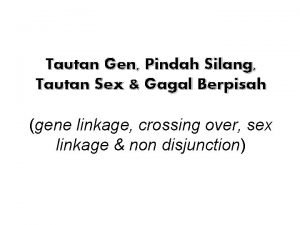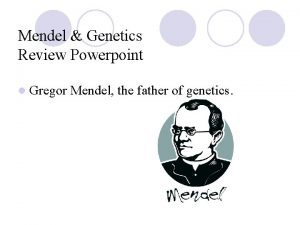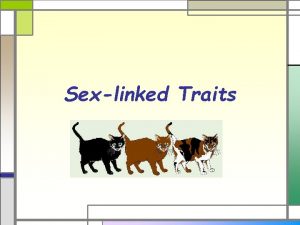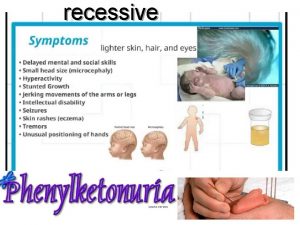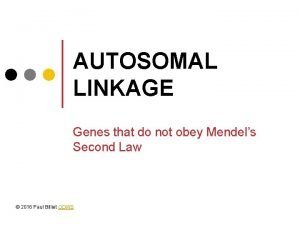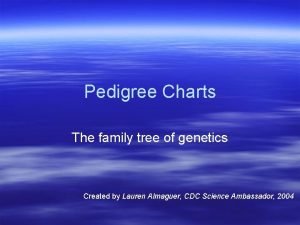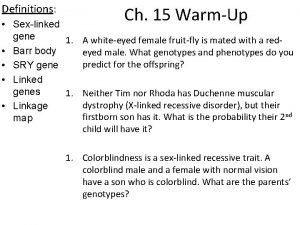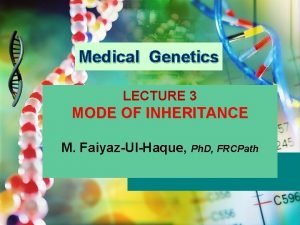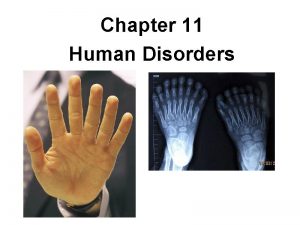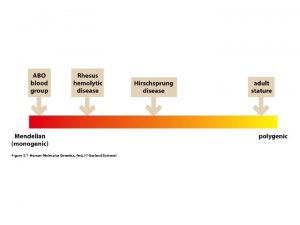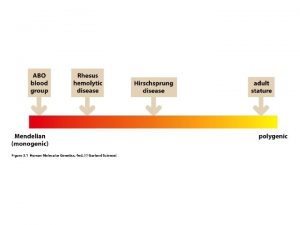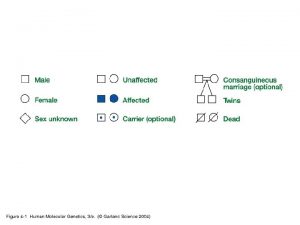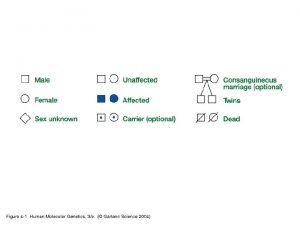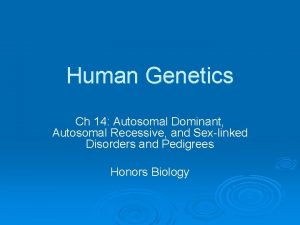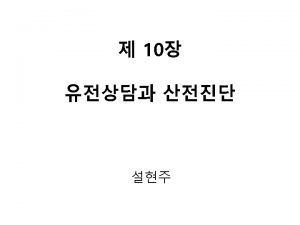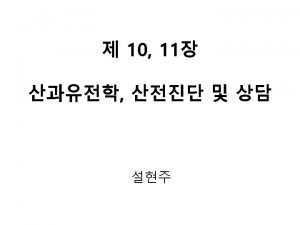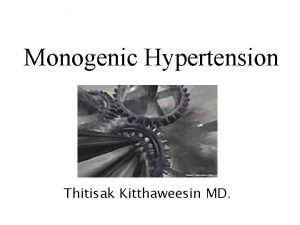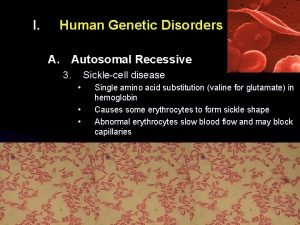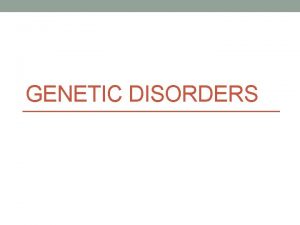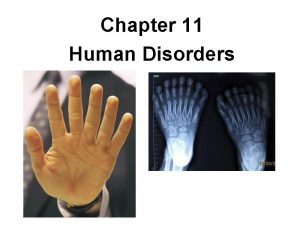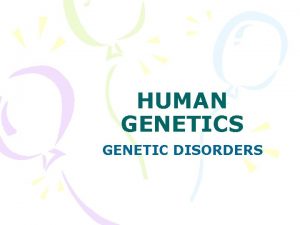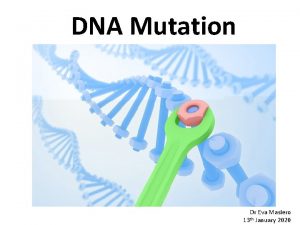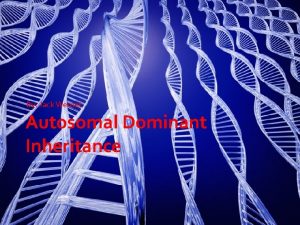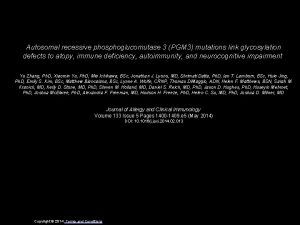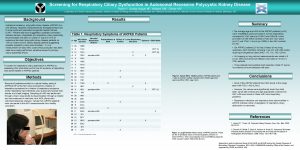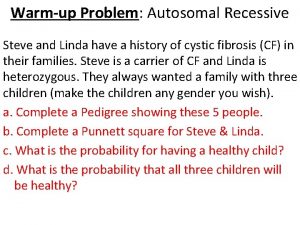Monogenic disorders Autosomal recessive disorder Dr Eva Masiero









































- Slides: 41

Monogenic disorders: Autosomal recessive disorder Dr Eva Masiero 21 st January 2020

Leaning outcomes • Understand the autosomal recessive inheritance • Draw out a Punnett square to show the different types of inheritance of alleles from two parents • Understand the implication of consanguineous marriages • Give an example of an autosomal recessive disorder: describe their clinical symptoms and draw a representative pedigree with genotype

Genetic terminology Term Genotype Definition Phenotype Gene The observable characteristic displayed by a cell or organism Allele Alternative forms of a single gene Homozygous (AA or aa) Heterozygous (Aa) Cells contain two identical alleles of a gene Monogenic disorders Punnett square Disease causes by a mutation in a single gene Pedigree analysis Graphic representation of a family history. It is a very important tool for studying human inherited diseases your genetic constitution, i. e. AA, Aa or aa A segment of DNA which normally specifies a functional polypeptide or RNA product. Cells contain two different alleles (one wild-type allele and one mutant allele) of a gene Diagram used by biologists to determine the probability of an offspring having a particular genotype

Punnett Square A Punnett square is a graphical representation of the possible genotypes of an offspring arising from a particular cross or breeding event. Mother genotype A A Father genotype A AA AA Possible offspring genotype

Pedigree symbols

Pedigree of the British Royal family (hemophilia)


Autosomal recessive (AR) § You need two mutant alleles (one inherited from each parent) in order to get the disease § Autosomal – mutated gene is on one of the autosomes (chromosomes 1 -22)

Autosomal Recessive Mum - carrier A a Dad - carrier A a A = normal allele a = mutant allele Dad Mum Aa Aa

Consanguineous marriage In clinical genetics, a consanguineous marriage is defined as a union between two individuals who are related as second cousins or closer. Parental consanguinity increases the autosomal recessive conditions because related persons are more likely to share the same disease-causing alleles.

AR family tree –inheritance characters Ø Horizontal pedigree male and female are equally affected Trait expressed in the homozygote (aa) = affected Trait expressed in the heterozygote (Aa) = unaffected/carrier If both parents are carriers the 25% of offspring is affected If one parent is a carrier and the other one is unaffected they will not have any affected child Ø Two affected parents cannot have unaffected children Ø High risk in consanguineous marriage Ø Ø Ø

Autosomal Recessive – Inheritance characteristic

Autosomal Recessive – Inheritance characteristic Consanguineous marriages Fig 1. 9 New Clinical Genetics 2 nd edition, Read and Donnai

Autosomal recessive disorders examples

Cystic Fibrosis (CF) • It is a life-threatening disorder that causes severe damage to the lungs, digestive system and reproductive systems • 1: 2500 incidence in North of Europe • Mutations in Cystic fibrosis transmembrane conductance regulator gene (CFTR) (7 q 31) Picture form: https: //ghr. nlm. nih. gov/gene/CFTR# • Symptoms: • Very salty-tasting skin • • Persistent coughing Frequent lung infections including pneumonia or bronchitis Wheezing or shortness of breath Poor growth or weight gain despite a good appetite

Cystic Fibrosis Pancreas: • 85% of CF patients have pancreatic insufficiency • pancreas is unable to secrete digestive enzymes - malabsorption of nutrients Lung problem: • repeated lung infection and difficulty breathing due to thick, sticky mucus which clogs the lungs • 90% of CF patients died from a destruction of the airways and lung tissue due to a combination of airway obstruction, inflammation, and infection.

Medical genetics –e-book; Lynn B. Jorde, John C. Carey, and Michael J. Bamshad

cystic fibrosis transmembrane conductance regulator (CFTR) • CFTR gene codes for a cystic fibrosis transmembrane conductance regulator (CFTR) protein • Cytogenetic Location: 7 q 31. 2 • CFTR protein is a member of the ATP-binding cassette (ABC) transporter superfamily.

Cystic fibrosis transmembrane conductance regulator (CFTR) • CFTR protein functions as a channel across the membrane of cells that produce: • mucus • sweat • saliva • tears • digestive enzymes • CFTR is involved in regulating the transport of chloride ions (Cl−) across epithelial cell membranes The transport of chloride ions helps control the movement of water in tissues, which is necessary to produce thin, freely flowing mucus

CFTR- structure • 2 membrane-spanning domains (MSD 1/TMD 1 and MSD 2/TMD 2): each composed of 6 transmembrane segments, form the CFTR channel pore MSD 1/TMD 1 • 2 nucleotide-binding domains (NBD 1 and NBD 2): bind the nucleotide molecule ATP to regulate channel activity —opening and closing of the MSDs • 1 regulatory domain (R): regulates channel activity and can be considered to be the ‘trigger’ governing whether the channel opens or closes, to activate the channel MSD 2/TMD 2 R NBD 1 NBD 2 Figure from: https: //www. cftrscience. com/? q=CFTR-protein-structure

CF - Genetic causes • More than 1, 700 mutations in the CFTR gene have been identified in people with cystic fibrosis • Mutations in the CFTR gene disrupt the flow of chloride ions and water across cell membranes causing the production of thick and sticky mucus • This mucus clogs the airways and various ducts, causing the characteristic signs and symptoms of cystic fibrosis.

Cystic fibrosis Which molecular technique can be used to detect the mutation on the CFTR gene? https: //www. ncbi. nlm. nih. gov/pmc/articles/PMC 2985951/

Classes of CFTR mutations https: //www. dovepress. com/cystic-fibrosis-gene-mutations-evaluation-and-assessment-of-disease-se-peer-reviewed-fulltext-article-AGG

Classes of CFTR mutations Mutation class Class III Class IV Class VI Reduced CFTR Reduced protein quantity or function Reduced quan tity Reduced function Reduced quan tity CFTR protein defect Synthesis defect Processing defect Gating defect Conductance defect Splicing defect Stability defect Result No functional CFT R protein is formed CFTR protein is CFTR protein targeted for reaches the degradation cell surface with faulty channel regulation CFTR protein reaches the cell surface with reduced chloride permeation Reduced quantity of correctly spliced CFTR transcripts Functional CFTR protein reaches the cell surface but is unstable

Cystic Fibrosis: Screening Test • Sweat test: it measures the amount of salt chemicals (sodium and chloride) in the sweat. • Newborn screening test: measurement of the level of Immuno. Reactive Trypsinogent, or IRT (chemical released by the pancreas) • Carrier testing: A simple mouthwash or blood test can determine if you are a carrier of the defective gene that causes cystic fibrosis • Antenatal testing: test is usually offered to mothers with high risk of having a child with cystic fibrosis

Cystic fibrosis: treatments Lungs • Bronchodilator drugs which open airways by relaxing the surrounding muscles, relieving tightness and shortness of breath. • Antibiotics treat or control persistent infection. • Steroids reduce inflammation in the airways. • Mucolytics such as DNase break down mucus, making it easier to clear from the lungs. Digestive system • enzyme capsules that replace pancreatic enzymes in helping to break down food more effectively.

Molecular therapy for CF § Potentiators: Therapeutic agents that improve the channelopen probability and potentiate mutated CFTR gating § Correctors: are small molecules that improve the trafficking of mutated CFTR (Class II mutations, e. g. , F 508 del) from ER to the apical PM and increase CFTR cell surface expression. § read-through agents: reduce the ribosomal ability to proofread and enable ribosomes to skip the stop codon, leading to the formation of functional protein. § Amplifiers: are compounds that enhance the expression of CFTR protein, with a following increase of its quantity in the ER and the PM. § Stabilisers: are molecules that rectify the intrinsic protein instability and increase the CFTR residence time at the PM/decrease protein degradation rate from the PM. https: //www. nhs. uk/news/genetics-and-stem-cells/gene-therapy-breakthrough-for-cystic-fibrosis/ https: //www. frontiersin. org/articles/10. 3389/fphar. 2018. 01381/full

CF treatment: gene therapy • Gene therapy is designed to introduce genetic material into cells to compensate for abnormal genes or to make a beneficial protein. • It is a technique for correcting defective genes responsible for disease development • The genetic materials (DNA or RNA) is inserted into a persona’s cell using a carrier or vector Cancer information centre 2013

How Gene therapy works • A vector deliveries therapeutic gene into a patient’s target cell • The target cells become infected with the viral vector • The genetic material of the vector is inserted into the target cell • Functional proteins are expressed from therapeutic gene causing the cell to return to a normal state

How Gene therapy works • the desired gene is transfer into a target cell by a carrier • The target cells become infected with the viral vector • The genetic material of the vector is inserted into the target cell • Functional proteins are expressed from therapeutic gene causing the cell to return to a normal state Types of vectors: 1. Virus-mediated gene delivery system (Biological system) 2. Non viral gene-delivery system (Physical/Chemical system)

Cystic fibrosis: gene therapy Virus vector trail: Adeno-associated virus (AAV) Dis: Difficult to package CFTR gene inside Activation of immune response Retroviruses: Good efficiency of transfection of airway Cytoplasmic expression Dis: need repeat administration Activation of immune response Picture from: http: //genetics. thetech. org/ask 291

Cystic fibrosis: gene therapy Liposome vector Trial liposomes do not trigger an immune reaction and so can be administered over and over again. They are not very efficient at getting their genetic cargo into the host nucleus Picture from: http: //www. pharmaceutical-journal. com/news-and-analysis/features/developing-gene-therapy-to-treat-cystic-fibrosis-challenges-and-successes/20201275. article#fn_1

Learning outcomes - summary • Autosomal conditions arise due to mutations on one on the autosomes (chromosomes 1 -22) • A Punnett square or cross-over diagram can be drawn to illustrate the inheritance of alleles from two parents and work out the probability of having an affected child • Since a consanguineous marriage involves the marriage of two related individuals the gene pool (= genetic variability) is reduced. • In consanguineous marriage there is a higher chance that any disease-associated mutation will occur in two close related individuals • Cystic fibrosis is an examplesof autosomal recessive disorders and each has a specific set of symptoms that make up the syndrome

Autosomal recessive – Recap exercise • You need to inheritance ………… in order to suffer from the disease • AR genotype: AA = aa = Aa = • List the three main inheritance characteristics of this AR family tree

Autosomal recessive – Recap exercise A B Identify the genotypes of the member of the family indicate by the arrows A: B: C: D: E: C E D

Autosomal recessive – Recap exercise Calculate the possible genotypes of the offspring for the following situations: Mum - affected a a Dad - carrier A a Mum - carrier A a Dad - affected a a Mum - affected a a Dad - unaffected A A A = normal allele a = mutant allele

Autosomal recessive – Recap exercise Explain the physiology and the genetic causes of cystic fibrosis

Autosomal recessive Possible genotypes (affected/carrier/unaffected): Cystic Fibrosis Physiology Genetic cause Example Punnett square Example pedigree (family tree) Consanguineous marriage Definition Why might consanguineous marriages increase the risk of recessive conditions

Reading Materials New Clinical Genetics, 3 rd edition (2015), Read and Donnai – Library Case 2: cystic fibrosis Medical Genetics – e-Book – chapter 4

Reading Materials • Cystic Fibrosis: • • https: //www. omim. org/entry/219700 https: //ghr. nlm. nih. gov/condition/cystic-fibrosis#statistics https: //cysticfibrosisnewstoday. com/types-of-cftr-mutations/ https: //www. dovepress. com/cystic-fibrosis-gene-mutations-evaluation-andassessment-of-disease-se-peer-reviewed-fulltext-article-AGG

 Dominant and recessive genes
Dominant and recessive genes Autosomal dominant vs autosomal recessive
Autosomal dominant vs autosomal recessive Sex linked pedigree
Sex linked pedigree Eva masiero
Eva masiero Generations in a pedigree
Generations in a pedigree Autosomal recessive cystic fibrosis
Autosomal recessive cystic fibrosis Thalassemia autosomal recessive
Thalassemia autosomal recessive Autosomal recessive
Autosomal recessive Recessive trait
Recessive trait Autosomal recessive
Autosomal recessive Hydrops fetalis
Hydrops fetalis Turricephalus
Turricephalus Monogenic diabetes
Monogenic diabetes Corinne masiero germinal
Corinne masiero germinal Marfan syndrome genetics
Marfan syndrome genetics Dominant vs recessive genetic disorders
Dominant vs recessive genetic disorders Somatic vs factitious
Somatic vs factitious Practice pedigrees
Practice pedigrees Autosomal dominant
Autosomal dominant Example of sex linked pedigree
Example of sex linked pedigree Two copies of each autosomal gene affect phenotype
Two copies of each autosomal gene affect phenotype Autosomal vs sex linked
Autosomal vs sex linked Trisomy 13 pictures
Trisomy 13 pictures Is turner syndrome autosomal or sexlinked
Is turner syndrome autosomal or sexlinked Autosome
Autosome Aplastic anemia lab findings
Aplastic anemia lab findings Sexlinked vs autosomal
Sexlinked vs autosomal Two copies of each autosomal gene affect
Two copies of each autosomal gene affect What are sexlinked traits
What are sexlinked traits What is a dihybrid cross
What is a dihybrid cross Trisomy examples
Trisomy examples Is methemoglobinemia autosomal or sexlinked
Is methemoglobinemia autosomal or sexlinked Phenylketonuria is autosomal or sexlinked
Phenylketonuria is autosomal or sexlinked Apa itu tautan gen
Apa itu tautan gen Autosomal vs sex linked
Autosomal vs sex linked Sexlinked traits definition
Sexlinked traits definition Pku is autosomal or sexlinked
Pku is autosomal or sexlinked Autosomal linkage
Autosomal linkage Xyy syndrome
Xyy syndrome Pedigree chart definition
Pedigree chart definition Blindness
Blindness Autosomal dominant punnett square
Autosomal dominant punnett square
